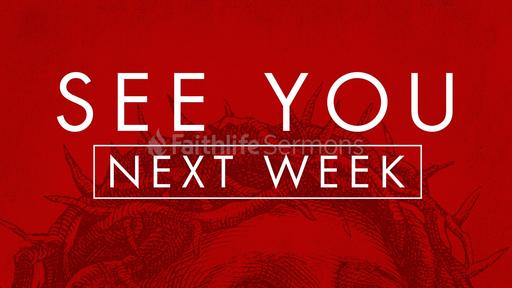Healing Interrupted
Journey through Matthew • Sermon • Submitted • Presented
0 ratings
· 4 viewsNotes
Transcript
Welcome
Welcome
Offering
Offering
Ways to Give and Pass the Bucket
Announcements
Announcements
KU Chi Alpha Missionaries
Tanner and Nicole Hedstrom
Let’s Jump into today’s message.
If you are new to our church today, it would be helpful for you to know that we practice a form of preaching called “Expository Preaching”.
What that means, is we believe the Bible is best taught by taking books of the Bible and then breaking them down from beginning to end, chapter by chapter, verse by verse. Our goal, to better understand not only what God’s Word says, but what it means in our lives today.
We are currently walking through the NT book of Matthew.
For the last three weeks the Narrative has centered around Jesus Calling Matthew to follow him. Like I said two weeks ago there is nothing better than a salvation story.
We also have learned that the celebration meal that Matthew put together brought a learning opportunity for both the Pharisees and some followers of John the Baptist.
Today, we come to an interruption in that celebration that leads to another interruption. Like I have said through out this study ministry never goes as planned we have to be understanding when it comes to divine opportunities and interruptions.
Let’s Jump into today’s scripture.
18 As he was telling them these things, suddenly one of the leaders came and knelt down before him, saying, “My daughter just died, but come and lay your hand on her, and she will live.”
19 So Jesus and his disciples got up and followed him.
20 Just then, a woman who had suffered from bleeding for twelve years approached from behind and touched the end of his robe,
21 for she said to herself, “If I can just touch his robe, I’ll be made well.”
22 Jesus turned and saw her. “Have courage, daughter,” he said. “Your faith has saved you.” And the woman was made well from that moment.
23 When Jesus came to the leader’s house, he saw the flute players and a crowd lamenting loudly.
24 “Leave,” he said, “because the girl is not dead but asleep.” And they laughed at him.
25 After the crowd had been put outside, he went in and took her by the hand, and the girl got up.
26 Then news of this spread throughout that whole area.
There is a lot going on here so let’s unpack the story.
Jesus is in the middle of a party turned teaching moment.
18 As he was telling them these things, suddenly one of the leaders came and knelt down before him, saying, “My daughter just died, but come and lay your hand on her, and she will live.”
So Who is this guy.
To find out we turn to Mark and Luke’s account.
The Man’s name is Jarius and we find out that He is the Ruler of the Synagogue. Particularly the Synagogue in Capernum.
This is what Barclay says of the this man.
He was elected from among the elders. He was not a teaching or a preaching official; he had 'the care of the external order in public worship, and the supervision of the concerns of the synagogue in general.' He appointed those who were to read and to pray in the service, and invited those who were to preach. It was his duty to see that nothing unfitting took place within the synagogue; and the care of the synagogue buildings were in his oversight. The whole practical administration of the synagogue was in his hands.
He was elected from among the elders. He was not a teaching or a preaching official; he had 'the care of the external order in public worship, and the supervision of the concerns of the synagogue in general.' He appointed those who were to read and to pray in the service, and invited those who were to preach. It was his duty to see that nothing unfitting took place within the synagogue; and the care of the synagogue buildings were in his oversight. The whole practical administration of the synagogue was in his hands.
This tells us that this man is a Pharisee appointed by the Pharisees to make sure everything in the synagoge was done orderly, respectfully, and proper worship.
This man bursts into the the room and kneels before Jesus.
This is not orderly.
This is absolutely disrespectful in the eyes of the Jews who.
Were very sensitive to anything that seemed like blasphemy or idolatry.
Jews would not handle Roman coins because they were stamped with the image of Caesar, who claimed to be a god.
Jews wouldn’t kneel before another person in authority, not even before a prophet or the King of Israel.
Because the posture of kneeling was reserved for worshipping God.
6 Come, let’s worship and bow down; let’s kneel before the Lord our Maker.
This man’s posture before Jesus indicates he is worshipping Jesus.
This man’s posture before Jesus indicates he is worshipping Jesus.
This tells us that the ruler truly believed Jesus was worthy of worship.
This tells us that the ruler truly believed Jesus was worthy of worship.
And given his position in the synagogue, his act of kneeling before Jesus demonstrates supreme faith
Such a display of reverence before a human being would have been cause for a charge of blasphemy by the Pharisees
Though the man was probably not charged, he could have been sentenced to death for what he did
Yet the ruler seemed to understand that if he hoped to see Jesus heal his daughter, he couldn’t hold back his worship
He had to be willing to put everything on the line to worship Jesus
His reputation, his occupation, his acceptance in the community, even his own life
He acted in faith toward Jesus because he was desperate to see his daughter restored
Do you see the common theme here. Putting your trust in Jesus is not something you do haphazardly.
Matthew gave up everything including his livelihood to follow Jesus.
This Man is putting his life on the line including his livelihood in order to see a miracle.
Again I want you to realize it is not what you know-It is what you do with what you know.
Matthew records that the daughter has died. However Mark and Luke record that she is dying. Regardless of the fact we will find that she is in fact dead when Jesus arrives.
What we do need to notice is in the midst of his 12 year old daughter dying this man leaves his house to find Jesus.
Jairus makes his appeal of Jesus in a demonstration of faith, and Jesus responds by agreeing to follow the man back to his house.
No this is where the second interruption takes place.
19 So Jesus and his disciples got up and followed him.
20 Just then, a woman who had suffered from bleeding for twelve years approached from behind and touched the end of his robe,
21 for she said to herself, “If I can just touch his robe, I’ll be made well.”
22 Jesus turned and saw her. “Have courage, daughter,” he said. “Your faith has saved you.” And the woman was made well from that moment.
All three writers include this story the same way with the interruption.
This tells us that all three saw these stories as have some kind of relationship.
So let’s break this down for everyone.
Matthew says nothing about a crowd but both Mark and Luke said that a crowd pressed in on them as they were headed to Jarius’ house.
Luke describes the crowd using a Greek word meaning “to choke out”, meaning the crowds felt suffocating.
It was like trying to move through a dense crowd at a concert or at the entrance of a football game
Jarius is most likely leading the way trying to cut a path through the crowd to get Jesus to his daughters.
Mean while the disciples are surrounding Jesus like the Secret Service.
Then, from somewhere behind Jesus, up comes this woman, fighting her way through the crowd, determined to get to Him.
All three Gospels say she had been hemorrhaging for 12 years
Though we don’t know for sure how she was bleeding
But most likely, it refers to her menstrual cycle running unabated for 144 months
By the way, Luke also mentions that Jairus’ daughter was 12 years old when she died
That curious similarity further suggests there’s a linkage between these two accounts
This means that according to Leviticus chapter 15 this woman has been completely cut off from everything.
First and foremost, as long as a person was in this condition, she was considered ritually unclean
And while a person is unclean, everything the person touched was unclean
And anyone who touched her or her bedsheets or garments would become unclean
For twelve years this woman has been untouchable.
Mark and Luke both tell us that she has exhausted all her money and seen every physician only to have her situation get worse.
Here she is in a desperate situation, so she sneaks up without announcing herself.
She knows several thing to be true.
First, she knew rabbis generally wouldn’t touch her or even speak with an unclean woman
Secondly, and more likely, she was afraid of making her situation known to the crowd
Given how tightly everyone was packed around Jesus, they would never have allowed her to rub shoulders with them
So she knew the only chance she had to get to Jesus was to keep her secret to herself.
But she had Heard the Jesus guy might just be the Messiah and he had the power to heal.
So she moves in but there is something different to her approach.
21 for she said to herself, “If I can just touch his robe, I’ll be made well.”
This sounds like a weird superstition but what is happening here is that this lady is actually placing faith in a prophecy that had been foretold by one of the Prophets of the First Testament.
But to understand that we have to understand the clothing in Jesus’ Day.
Typically, men wore two garments: a light under tunic, almost like underwear, and an outer tunic or robe
Then over the robe, a man wore a long shawl called a tallit, sometimes called a prayer shawl today
The tallit was rectangular and was draped over the shoulders and extended down almost to the length of the robe
Off the four corners of the tallit hem, called wings, hung tassels of knotted thread call tsitsityot
The Lord instructed Israel to make these tassels in the Law
37 The Lord said to Moses,
38 “Speak to the Israelites and tell them that throughout their generations they are to make tassels for the corners of their garments, and put a blue cord on the tassel at each corner.
39 These will serve as tassels for you to look at, so that you may remember all the Lord’s commands and obey them and not prostitute yourselves by following your own heart and your own eyes.
40 This way you will remember and obey all my commands and be holy to your God.
Traditionally, these cords were knotted five times to represent the 5 books of the Torah: Genesis, Exodus, Leviticus, Numbers, Deuteronomy
Interwoven in the cord was as single blue thread to remind the nation of Israel that they were a kingdom of priests
Over time, these tassels became a very important symbol in Jewish society
Ordinary Jews typically wore their tallit only on special occasions,
But the Pharisees had taken to wearing them regularly, to attract more attention to themselves
And when that practice stopped gaining attention, the Pharisees invented a new tradition
Some enterprising Pharisee had the idea to increase the length of his tassels ever so slightly beyond the customary length, so as to stand out
When his fellow Pharisees noticed his exaggerated self-importance, a competition soon developed for who had the longest tassel
Later in this Gospel, Jesus mocks the Pharisees for their false piety
5 They do everything to be seen by others: They enlarge their phylacteries and lengthen their tassels.
Now let’s get back to this woman’s story,
She believed that all she had to do was touch the part of Jesus’ Tallit that was there to remind the Jews of the Word of God.
If she could just touch the tassel at the end of the robe she would be healed.
Sound crazy but she is in fact trusting the word of God and it is deeper than tradition.
She believed touching Jesus in this way would result in healing, because of her faith in a Messianic prophecy found in Malachi
Malachi 4:2 (CSB)
2 But for you who fear my name, the sun of righteousness will rise with healing in its wings, and you will go out and playfully jump like calves from the stall.
The prophet says those who fear the name of the Lord will see Him bring healing for His people
The prophet refers to the Messiah as the “sun of righteousness”
The Hebrew word for sun (shemesh) means “the sun in the sky”, while the Hebrew word, ben means “a male offspring” or “son”
The fact that those words sound alike in English is just a happy coincidence
If you read this same verse translated into any other language, you wouldn’t find that to be the case
Nevertheless, the context of the verse tells us Malachi was speaking about the Messiah, the Son of God
The rising of the sun in the sky is being used symbolically to represent the glorious arrival of the Messiah
And the dawning of the Kingdom of God
And what this woman remembered most about Malachi 4, was the prophet’s promise that when the Messiah came, He would have healing in His “wings”
Remember, “wings” is the name given to the four corners of the tallit where the tassels on a man’s garment were attached
In fact, the word translated “corner” back in Numbers 15:38, is kanaph, which literally means “wing”
So like all Jews, this woman grew up hearing that their Messiah would possess power to heal in His wings, or corners of his shawl
So this lady touches his wing and immediately she is healed.
21 for she said to herself, “If I can just touch his robe, I’ll be made well.”
22 Jesus turned and saw her. “Have courage, daughter,” he said. “Your faith has saved you.” And the woman was made well from that moment.
But there is something that Matthew leaves out!
Mark and Luke both state that Jesus felt power go out of him at the moment that she touched him which is why he stopped to ask who touch him.
This leads His Disciples to say
31 His disciples said to him, “You see the crowd pressing against you, and yet you say, ‘Who touched me?’ ”
Hey Jesus everyone is touching you.
But Jesus goes on to explain that power went out of him.
I want to remind everyone that Jesus was fully human in his time on the earth. He gave up the power of God when God sent Him to earth. It was only at His baptism and the Holy Spirit descending on Him that he began performing Miracles.
Jesus has been operating out of the Power of the Holy Spirit and it was that Power that he felt released from him.
So when Jesus turned to her what he said was that it was Her Faith that allowed the Holy Spirit to be released through Him and ultimately heal her.
What are we learning from this moment between Jesus and the woman?
1. The woman’s healing forms a picture of salvation.
1. The woman’s healing forms a picture of salvation.
She is unclean, excluded from the commonwealth of God’s people, until she comes to Jesus in faith
Her faith in the promises found in God’s Word draws her to Christ, and by the power of the Holy Spirit, she receives power
This happens on the basis of faith alone, even before she sees Jesus face to face
And her healing comes accompanied by a public confession, which results in her being reconciled to the family of God
2. Scripture teaches us that a person comes to faith based on hearing the Good News contained in the Word of God.
2. Scripture teaches us that a person comes to faith based on hearing the Good News contained in the Word of God.
We come to Jesus to have our sins washed away, to be made clean, by His blood.
By the power of the Holy Spirit, we are born again, cleansed and made new, though we have never seen Jesus face to face.
But having come to Him in faith, we then confess Him publicly. (Water Baptism)
And we are reconciled to God by our faith.
So as we close today what can we learn from this woman’s faith.
Living out our faith comes down to two behaviors.
1. We must live in complete trust that God is at work, keeping our eyes focused on the promises found in His Word.
1. We must live in complete trust that God is at work, keeping our eyes focused on the promises found in His Word.
2. When life throws us a trial or disappointment it is an opportunity to put our faith in God.
2. When life throws us a trial or disappointment it is an opportunity to put our faith in God.
A sick daughter is an opportunity to become more dependent on the Lord
A delay in getting help is an opportunity to learn a faith lesson or develop patience
An impossible situation is the opportunity to display great confidence in the Lord
As you reflect on this message this week ask yourself what kind of Faith is on display in your life.




